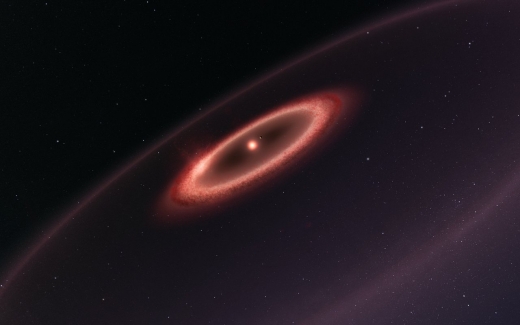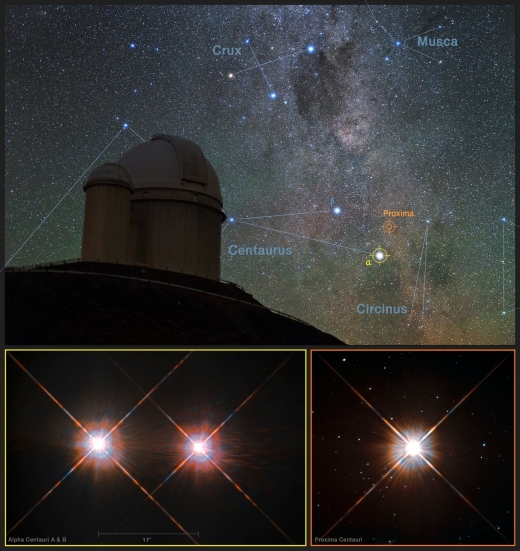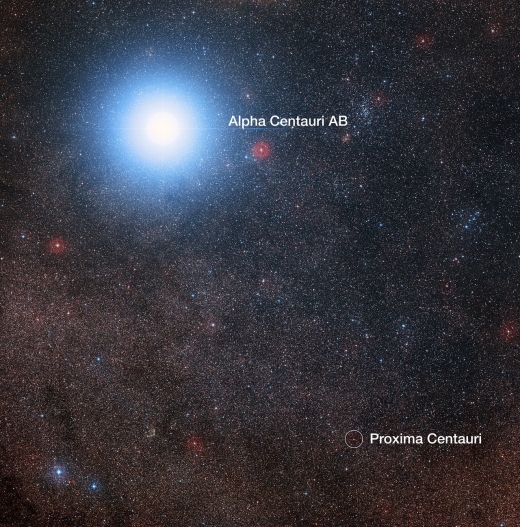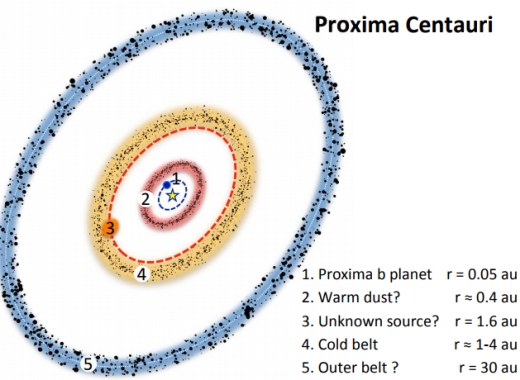Just how elaborate is the planetary system around the nearest star? It’s a question rendered more interesting this morning by the news that the ALMA Observatory in Chile has now detected dust in the system in an area one to four times as far from Proxima Centauri as the Earth is from the Sun. Moreover, there are signs of what may be an outer dust belt, an indication that while we have already discovered Proxima Centauri b, we are looking at a system in which cold particles and debris that could have formed other planets continue to accompany the star.

Image: This artist’s impression shows how the newly discovered belts of dust around the closest star to the Solar System, Proxima Centauri, may look. ALMA observations revealed the glow coming from cold dust in a region between one to four times as far from Proxima Centauri as the Earth is from the Sun. The data also hint at the presence of an even cooler outer dust belt and indicate the presence of an elaborate planetary system. These structures are similar to the much larger belts in the Solar System and are also expected to be made from particles of rock and ice that failed to form planets. Note that this sketch is not to scale — to make Proxima b clearly visible it has been shown further from the star and larger than it is in reality. Credit: ESO/M. Kornmesser.
It would surprise no one if Guillem Anglada-Escudé were the lead author of this work, as Anglada-Escudé led the effort that discovered Proxima b. But in this case, the Guillem Anglada who led the dust work, based at the Instituto de Astrofísica de Andalucía, Granada, Spain, simply shares Anglada-Escudé’s name — the two are not related. Further complicating matters is the fact that Proxima b discoverer Anglada-Escudé is a co-author of the paper on dust.

Image: This picture combines a view of the southern skies over the ESO 3.6-metre telescope at the La Silla Observatory in Chile with images of the stars Proxima Centauri (lower-right) and the double star Alpha Centauri AB (lower-left) from the NASA/ESA Hubble Space Telescope. Proxima Centauri is the closest star to the Solar System and is orbited by the planet Proxima b, which was discovered using the HARPS instrument on the ESO 3.6-metre telescope. Credit: Y. Beletsky (LCO)/ESO/ESA/NASA/M. Zamani.
Says lead author Anglada:
“The dust around Proxima is important because, following the discovery of the terrestrial planet Proxima b, it’s the first indication of the presence of an elaborate planetary system, and not just a single planet, around the star closest to our Sun.”
Given Proxima Centauri’s age, at least as old as the Solar System and perhaps older, we’re probably detecting residual dust from regions something like the Kuiper Belt and main asteroid belts in our own system. Such dust can also produce zodiacal light, which can be seen in our own system as sunlight is scattered by interplanetary dust, a faint but observable phenomenon.

Image: This image of the sky around the bright star Alpha Centauri AB also shows the much fainter red dwarf star, Proxima Centauri, the closest star to the Solar System. The picture was created from pictures forming part of the Digitized Sky Survey 2. The blue halo around Alpha Centauri AB is an artifact of the photographic process, the star is really pale yellow in colour like the Sun. Credit: Digitized Sky Survey 2. Acknowledgement: Davide De Martin/Mahdi Zamani.
The total mass of the inner belt appears to be about 1/100th of Earth’s mass, at a temperature of about -230 degrees Celsius, roughly the temperature in the Solar System’s Kuiper Belt. The inner belt appears to extend a few hundred million kilometres from Proxima Centauri, and could be quite a useful find if it helps us estimate the inclination of the Proxima Centauri system. The dust is assumed to be elliptical given the tilt of what is probably a circular ring around the star. Such a determination would offer us a way to tighten mass estimates of Proxima b.
And are there other planets waiting to be discovered here? Anglada again:
“This result suggests that Proxima Centauri may have a multiple planet system with a rich history of interactions that resulted in the formation of a dust belt. Further study may also provide information that might point to the locations of as yet unidentified additional planets.”
The paper speculates interestingly about a “compact source of 1.3 mm emission at a projected distance of ? 1.2” SE from the star…” which may or may not be an artifact in the equipment, but if real could be anything from a background galaxy (the authors consider this remote) to a Saturn-mass planet with a temperature around 1000 K. The problem: No radial velocity signature of such a planet has yet been found, although if it were there, it should be detectable.

Image: Figure 4 from the paper. Sketch (not to scale) of the proposed components in the Proxima Centauri planetary system. Question marks indicate marginally detected features. Credit: Anglada et al.
The paper is Anglada et al., “ALMA Discovery of Dust Belts Around Proxima Centauri,” accepted at Astrophysical Journal Letters (preprint).



The unknown source at 1.6 AU is OBVIOUSLY the start of construction of a megastructure aroubd Proxima Centauri. Keeping up with the Boyajians. lol.
This is a very interesting information and may help understand the layout of the Proxima Centauri system. There may be a relation to our Oort cloud and the outer belt at 30 au, the matter composing the Oort cloud may have formed closer to the Sun and was scattered far into space by the gravitational effects of the giant planets early in the Solar System’s evolution. The case in Proxima Centauri the 30 au belt could be caused by the planet at 1.6 au ejecting material from the belt at 1-4 au.
This also means that comets would be more common in the inner solar system and Proxima b should have been replenished with water and the other elements for life. After all, the year their is 1/33 of Earths so maybe an impact from a comet like Chicxulub might occur every two million years.
I hope in the near future that observations of the nearby red and K dwarfs such as Barnard’s star, Lalande 21185, Epsilon Eridani and TRAPPIST1 are made since this may indicate where to look for planets in those systems.
The discovery of a hot, super-Earth-size exoplanet orbiting Lalande 21185 was announced this past February:
http://www.drewexmachina.com/2017/02/18/our-new-neighbor-orbiting-lalande-21185/
I’m sure this system will get additional attention looking for more exoplanets. And Barnard’s Star was one of the targets (along with Proxima Centauri and Ross 158) for the Red Dots campaign which finished making its observations about a month ago.
http://www.drewexmachina.com/2017/07/03/red-dots-the-search-for-nearby-exoplanets/
So hopefully we will be getting some fresh RV results (positive or negative) about this star sometime in the next couple of months.
I have high hopes for Lalande 21185 and future RV searches . Not its hot “Super Earth” admittedly ,though hopefully that is the innermost of a Tau Ceti like system of big terrestrial planets . A rather congenial M2 star and sufficiently luminous to support a hab zone as far out as 0.25 AU. Perhaps a 2 Me with an optimal hot convective core and mantle simultaneously creating a sustained magnetosphere & thick atmosphere replenishing vulcanism – a la Ramirez ). Could be a good candidate for either ELT NIR imaging and/or high dispersion spectroscopy .
Proxima centauri, Wolf 1061, Gliese 86, Gliese 176, Gliese 180, Gliese 229, Gliese 433, Gliese 436, Gliese 581, Gliese 649, Gliese 667, Gliese 674, Gliese 682, Gliese 687, Gliese 849, Gliese 876, Tau Ceti, HR 8832, 55 Cancri, HD 40307, HD 95872, HD 102365, HD 192310, HD 219134, 82 G. Eridani, Luhman 16, Groombridge 64, Epsilon Indi, Kapteyn’s Star, Fomaulhaut, 61 Virginis, Pollux, Ross 458, Innes’s star…..
Soon easier to make list of nearby star without planet! =)
Epsilon Eridani has already been surveyed by ALMA: Booth et al. (2017) “The Northern Arc of ? Eridani’s Debris Ring as Seen by ALMA” – observations show the outer ring and indicate it is relatively narrow with sharp edges. What’s going on within 25 AU of the star is still not entirely certain (including the question of whether the claimed radial velocity giant planet b actually exists).
Exocomets in the Proxima Centauri system and their
importance for water transport.
“The scenario and the efficiency of water transport by icy asteroids and comets are still amongst the most important unresolved questions about the early phases of planetary systems. The detection of Proxima Centauri b (PCb), which moves in the habitable zone, triggered a debate whether or not this planet can be habitable depending on its formation history and available water content. A better understanding of cometary
dynamics in extrasolar systems shall provide information about cometary reservoirs and give an insight into water transport especially to planets in the habitable zone. In our study we perform numerous N-body simulations with PCb and an outer reservoir of comets. We investigate close encounters and collisions with the planet, which are important for the transport of water. Observers found hints for a second planet with a period up to 500 days. Our studies show that from the dynamical point of view two planets are stable even for a massive second planet with up to ? 12 Earth masses. The simulations of a possible second planet yield that this planet can stay in a stable orbit very close to PCb. For the study of exocomets we include an additional
planet outside of PCb in our calculations and we also consider the influence of the binary ? Centauri. The studies on the dynamics of exocomets reveal that the outer limit for water transport is between 100 and 200 au. From our simulations we estimate the water mass delivered to the planets to be between 0 and 30 Earth oceans.
https://arxiv.org/pdf/1711.04685.pdf
Fascinating discovery, Paul! Do you happen to know if ALMA has targeted Alpha Centauri A and/or B for similar observations?
I’m not aware of ALMA plans for Centauri A or B, I’m afraid, but will pass along anything I hear about this.
If interpreted as a substellar object, it would be of temperature 1000 K and an object massive enough to maintain that temperature at the age of Proxima Centauri is ruled out by the RV measurements. The Saturn-mass planet idea comes from interpreting the source as emission from a dust ring (rather than from the central object itself) and extrapolating from a theoretical prediction that rings would have a mass 10^-7 times the mass of the planet. So far there is no evidence for an RV signal corresponding to a planet of this mass, but further observations are necessary to confirm or rule this out. Other possibilities include a Trojan cloud associated with an unseen planet (invoking favourable placement to explain why we don’t see the cloud at the other Trojan point), or an uneven disc.
The disk is inclined at 45 degrees. So if it is coplanar with Proxima b that gives the planet a mass of just under or just over that of 1Me according to msini and within the RV error bars .
For a 45 degree inclination, the mass would be about 1.8 Earth masses. (Mass is increased over the minimum value by a factor of sqrt(2)?1.414)
Could there be a relation between this second source observed close to proxima and an object previously observed by Alma close to the alpha centauri system?
The outer dust belt, if that is wait it is , is situated at 1.2 arc secs from the star. That’s a big angular separation for such a nearby star. By way of comparison , the Earth at 1 AU from the Sun would subtend an angle of 0.1 arcsec as observed from 10 parsecs. Proxima is just 1.3 PC away . So with angular separations inversely proportionate to distance , any outer disk should be centred around 92 AU.
It’s looking as if Proxima is a relatively dusty system. Presumably that means it’s exozodiacal light level is likely to be high , making any future direct imaging difficult . The star is of similar age to the Sun or indeed greater. This all seems to suggest it’s system having being “jiggled ” up at some point or points in the more recent past which might fit with the disruption of gravitational capture by the Alpha Centauri A/B binary as recently mooted.
If so, what effect would that have had in turn on Alpha Centauri A/B and their respective systems ? If feasible an ALMA survey would certainly seem to be indicated .
The 0.7m EXCEDE MIDEX planetary disk surveyer concept telescope would lend itself very nicely to this area .
Alien life? Don’t expect it to be all that different, Oxford University researchers say.
Very well done article about life around Red Dwarfs with videos and interactive 3D models.
http://www.news.com.au/technology/science/space/alien-life-dont-expect-it-to-be-all-that-different-oxford-university-researchers-say/news-story/dccb989241b084a56da71957b1a8cdfa#
http://www.adelaidenow.com.au/news/special-features/in-depth/red-dwarf-star-life-but-not-as-we-know-it/news-story/cc9a82b90f9d1d7003267b49482d6379
Regarding the story about what alien life would look like, I find myself in agreement with PZ Myers’s take on it.
It would not surprise me if there was a planet or large asteroid between 2 and 3 which is sheparding the dust rings.
Don’t get too excited, folks. Speculation is already spinning out of control. It might take many months or years of investigation to either confirm or deny even the most informed speculation.
Not necessarily that long. The Pale Red Dot team have just completed the latest precision RV and photometry survey of several nearby late M stars including Proxima.
If Proxima Centauri is an obvious Starshot candidate due to its (er) proximity, and it’s particularly dusty, how would this affect any probes? It could be a problem, but on the other hand I guess it depends on the inclination of the probe’s trajectory to Proxima’s orbital plane. It wouldn’t be so bad if the probe is merely cutting across the orbital plane.
If we did have probe going to Proxima just before arrival in the system we could use it as a gravilens, should be able to see quite a bit of really deep space.
One thing I don’t see mentioned anywhere is that the data narrow the possible inclination to ~40° +13°/-10°, narrowing the mass range of Proxima b to 1.95 +0.93/-0.6 earth masses https://www.eso.org/public/archives/releases/sciencepapers/eso1735/eso1735a.pdf
Paul Gilster: ANOTHER Proxima b CANDIDATE transit event presented by a DIFFERENT GROUP OF OBSERVERS with a GROUND-BASED telescope! “Photometry of Proxima Centauri in Antarctica: A Candidate Transit Event of its Earth-sized Planet.” by Liu, Hui-Geni, Jiang, Peng. THIS candidate is NOT consistant with the TIME FRAME of Kipping and Davenport’s two candidates, indicating that, if ALL THREE are ACTUAL TRANSITS, Proxima b would exhibit TTV’s caused by the PUTATIVE Proxima c. What I do NOT know is IF the NEW candidate transit event produced a RADIUS for Proxima b CONSISTANT with BOTH radii exhibited to Kipping and Davenport by the MOST space telescope. Kipping and Davenport kept the purported radii of BOTH OF THEIR CANDIDATE TRANSIT EVENTS UNDER WRAPS, but it would be VERY INTERESTING if all three radii are the SAME. Could you ask them if this is the case, and; what their overall take is on this NEW candidate?
If I can learn anything more about this, Harry, I’ll publish it here.
As you know, I harp A LOT on on “co-incidences” in my comments. After learning about the 45 degree tilt of the dust belt(s?) orbiting Proxima Centauri, I originally thought that the transit issue for the planet had been FINALLY resolved in the NEGATIVE, however; after finding out about this new transit candidate, I remembered something VERY IMPORTANT: The ONLY TWO stable configurations for two planets orbiting close to each other are ONE: Co-planar, and; TWO: 40 degree angle. I now wonder if 40 degrees is within the ERROR BOX for the tilt of the dust belt(s?)? If the CONFIRMED dust belt is INDEED being sculpted by the putative Proxima c in an orbit in the FAR END of its projected range of possibilities, the two planets COULD BE ARRANGED IN THIS CONFIGURATION! This is VERY IMPORTANT, because the TTV effect of Proxima c on Proxima b would be VERY DIFFERENT for the tilt configuration as opposed to the co-planar one.
Paul Gilster. Looks like you may have to publish SOMETHING on this very soon. The paper is now up on the exoplanet.eu website. I checked out the PDF and, if this is an ACTUAL transit, Proxima b’s radius would be ~1.25 Rearth. If Proxima b has a composition EXACTLY THE SAME AS EARTH’S, the radius would be 1.08Rearth, meaning, to me anyway, that Proxima b’s solid surface would be COMPLETELY COVERED BY A GLOBAL OCEAN and would have a dense atmosphere in the range of 10-100 bars! There could be life there, but, alas, humankind would not want to deal with such a thick atmosphere, even if it had the means to do so. Therefore, we will most likely confine this planet to the realm of the automatons!
Harry, you’ve said that Kipping’s results are under wraps, but they’re not:
https://arxiv.org/pdf/1609.08718.pdf
See Table 4. He describes his fits as “…pretty consistent with the new result” in an email this morning. Interesting, but now we wait for confirmation, as the paper makes clear. We don’t know whether or not we have an actual transit here. Will keep an eye on future observations.
What I meant by “under wraps” was what transit depth is required to produce a RESULT of a 1.08Rearth radius. The new paper states that it would be 0.48%. This was not mentioned in the Kipping paper, so that ONLY astronomers who knew this would be able to derive the radius from the graph in the Kipping paper. I “derived” the APPROXIMATE radius from the new paper by measuring the transit depth depicted by the graph in the new paper with a ruler, and calculating it to be ~0.6%.
Maybe not… see this arXiv paper from MacGregor et al. – apparently the infrared excess can be explained by flares, while the ~30 AU ring may be contamination by background sources.